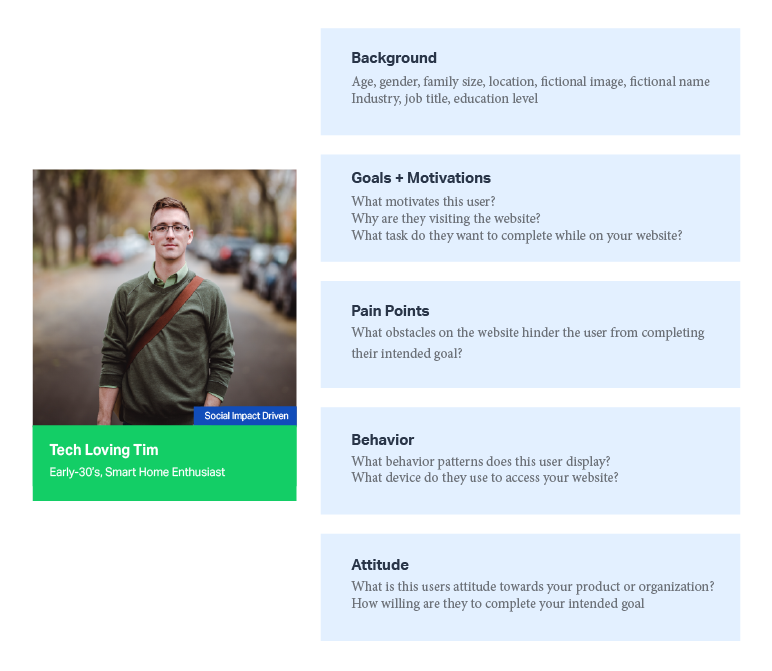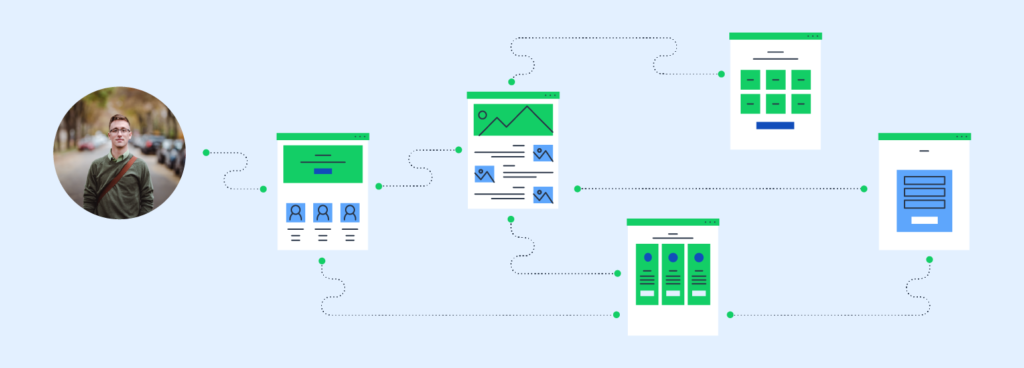In this blog, we’re diving into how to create user personas and user flows, two foundational elements of the website strategy process. After all, it’s your users who are at the heart of why you have a website to begin with.
When developing a website it is important to ask yourself two important questions:
“Who are we designing for?” and “How will they interact with this website?”
The answers to these questions can be unraveled by developing thoughtful user personas and user flows (sometimes called UX flows).
Who are we designing for?
While you may not know each person by name, you can sort users into categories called user personas. As Hubspot says, “Personas are fictional, generalized characters that encompass the various needs, goals, and observed behavior patterns among your real and potential customers.”
What makes up a persona?
Personas should personify any existing data you’ve gathered into different fictional users. They should contain enough detail to inform content strategy, while still encompassing a general group of people. Typically, data is sorted into 4-8 different user personas, but there’s no hard and fast rule. Here are the key pieces of information you should include when developing personas:

This information is found through quantitative and qualitative research methods. Quantitative research will uncover hard facts such as demographics while qualitative research will uncover user insights such as attitude and behavior. The depth of research will ultimately depend on your organization’s preexisting budget and capabilities.
Why are user personas important?
Personas drive design and development decisions. They help to embody data into what could be a real person. User personas help teams understand the why and who behind content strategy, creating a real point of focus in every single marketing activity. Creating user personas is a vital step in the process of building any website (and in marketing that website after it’s built!).
How will they interact with the website?
After developing user personas, you can explore and define the paths that users might take through your website to achieve a goal. Designing this path is called a user flow or UX flow.
What makes up a user flow?
User flows typically consist of 4-12 steps, and they help to focus on the overall needs of a user. They create a clear picture of the journey a user persona may take when navigating a website, down to which links a user might click and what pages they’ll visit. In other words, having a clearly defined user flow helps not only to identify potential problems but also to find ways to enhance user journeys.
Here’s an example of user flow:

How to design a user flow in 3 steps
- Objectives: the first step is establishing what objective or end goal you want the user to achieve. This could be purchasing an item, signing up for a service, or filling out a form. Ultimately you want to ask yourself, “What do we want this user to do while on our website?”
- User flow entry point: This step is all about determining where users are entering your website from. Determining a user’s entry point allows you to craft a flow around their behavior and goals. Some typical entry points include: organic search, paid advertising, email, or direct link.
- Information and timing: When designing a user flow, it is important to consider what information the users need at each stage of their journey. The information at each stage should guide the user to the next step in your user flow.
Creating user personas and user flows go hand-in-hand to developing a website that works for your organization. User personas allow you to get to know your audience and user flows let you walk in the path your users may take. These steps are important to inform marketing, development and design decisions.
Need help with creating user personas and flows? Let us help you!
Updated: Nov 27, 2024
 Kati Terzinski
Kati Terzinski Erin Murray
Erin Murray